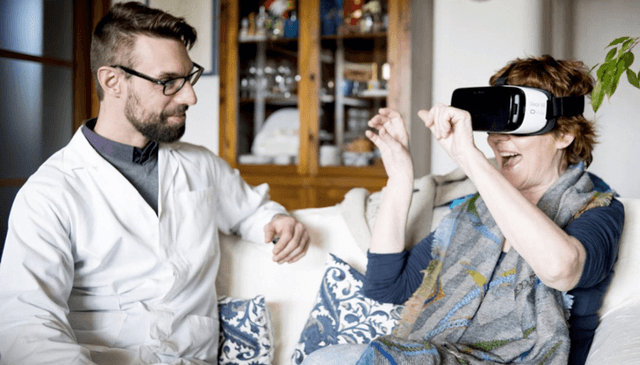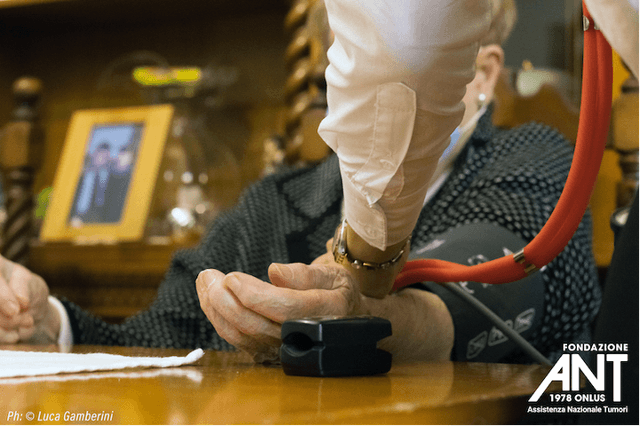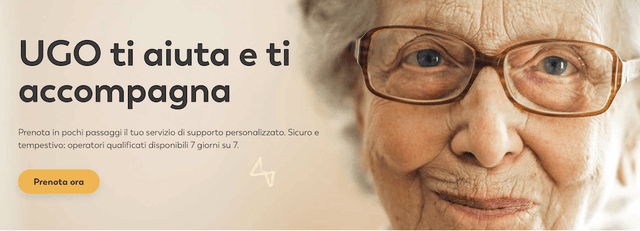ANT Foundation: how new technologies delivered the human touch during Covid-19
- Exhibited by
- Veronica Parise
- Added
- February 17, 2022
- Medium of Communication
- Digital, online
- Target Audience
- All donors
- Type of Charity
- Health
- Country of Origin
- Italy
- Date of first appearance
- 2020
SOFII’s view
The coronavirus pandemic threw up a wide range of issues for all charities but for Italy’s ANT Foundation (National Cancer Assistance) it could have been seriously damaging. A game-changer. Lockdown rules meant they could no longer fundraise in public squares or other places where they could gather in large groups. And it put limitations on how they could treat and help their beneficiaries. So, they had to think innovatively while maintaining their core focus on care and the human touch.
By partnering with two technology companies ANT Foundation were able to bring their care to people stuck at home, be it via a tailored app, a joypad inspired by video gaming or a virtual reality platform. These innovations sparked a huge response among donors, and that support continues to grow. This is a super example of Italian fundraising and evidence that if you stick to your core values, and marry them to new technologies and ideas, you can help your beneficiaries and inspire others to give.
Introduction
How did technological innovation make a difference to fundraising at the ANT Foundation?
Advances in technology have always influenced the development of human cultures and societies, often leading to changes in human behaviour and even major shifts. This was the case for the Italian National Cancer Assistance Foundation (also known as the ANT Foundation), because the coronavirus pandemic meant they could no longer provide support to patients in person. By thinking creatively, and reacting to the huge challenge of coronavirus, they were able to transform the way they helped people in a new and original way.
Through the use of certain technologies and specific tools and techniques, the ANT Foundation managed to improve their home care for cancer patients, achieving really interesting results.
Thanks to partnerships with private companies that use innovative digital platforms, namely Hello UGO and the virtual reality project The Look of Life, they have been able to continue offering services to the cancer patients that need them.
Read on to find out how they did it.
Background
The ANT Foundation was founded in 1978 and guarantees free home-based specialist medical assistance for cancer patients and families through highly functional structures.
22 hospitals ‘without walls’ exist as a sort of itinerant structure, consisting of a professional home assistance service made up of doctors, nurses and psychologists. They work together according to the basic principle that people have the right to be treated at home, favouring local health care.
Inspirational and motivational people – the core idea
The ANT Foundation was established thanks to the great intuition of Professor Franco Pannuti, a distinguished oncologist who passed away in October 2018. Like all great minds, he bequeathed his ideas, firstly that of human scale health – where patients can choose to live and be treated for their condition at home, among their loved ones, relying on specialised assistance, usually managed by the hospital.
Those who turn to ANT are mainly families who are living through the terrible experience of seeing loved ones suffering with cancer. ANT provides effective support to the patient, as well as psychological support to the patient and their families—often when they are mourning.
Summary / objectives
So how was it possible to reach and exceed the organisation’s objectives, and still make a difference to patients and families during the pandemic? The coronavirus emergency put a strain on the traditional methods of fundraising of the ANT Foundation, which had always been based on physical contact between the donor and the organisation in the city and town squares, as well as in offices during events.
This unprecedented situation led them to experiment with new hybrid methods and tools, leading to fundraising through digital technology, which offers the opportunity to involve donors wherever they are.
Special characteristics
Humanisation. This is the key word that defined the turning point in ANT’s innovation. Always attentive and sensitive to the needs of human beings, ANT has long been committed to finding methods that can make treatment protocols ‘more human’.
It is not surprising in fact that an increase in psychological support arose when a dedicated toll-free numberwas activated. The coronavirus emergency has been a severe test on the psychological strength of people, and relying on psychologists and psychotherapists during isolation was an effective support.
But the pandemic provided a further impetus for the foundation to innovate even more.
This even extended to the use of gaming tools in treatment. The coronavirus emergency fuelled fear, anxiety and a state of fragility in cancer patients, significantly impacting the progress of healing, especially for those not in a terminal condition.
One such development was a joypad that served as a monitoring tool for measuring vital parameters for remote symptom control. This is obviously not gaming as in entertainment—the joypad was a remote blood pressure monitor, meaning it also adhered to coronavirus safety rules.
Thanks to its continuous focus on innovation, ANT also identified a start-up that has adapted its business model to the specific needs of care services: the Hello Ugo app (https://hellougo.com/).
Hello Ugo (UGO) brings together in real time those who need support with those who can provide it, in full compliance with safety standards, reaching the patient at home, accompanying them to the hospital and supporting them in every activity, until they can return home.
UGO’s app provides not only logistical and physical support to patients, but also psychological support, characterised by the strong empathy that is intrinsic to ANT’s carers. These people are a quiet presence inpatients’ daily lives, performing their tasks with delicacy and discretion, acting as ‘travel companions’. And the app reflected that.
The service also has a second social impact: a real job opportunity for prospective staff. From accompanying treatment to carrying out errands or delivering groceries and medicines, up to providing company or telephone support to the sick. It is very simple to register on the platform and reach someone helpful in real time.
An internal team of doctors and university professors evaluate and search for innovative projects where technology can have positive effects on the humanisation of care. For ANT this is an important asset to generate funds, as donors are very sensitive to these matters.
UGO was awarded the first prize of the ‘SPRINT4IDEAS’ awards in 2018.
Silvia Ciresa, ANT Innovation and Development Coordinator told us: ‘the empathy process was so engagingthat in some cases people always asked to be accompanied by the same drivers’.
All this reflects that crucial element of humanisation.
But it is from the voice of those who have lived the experience that everything takes on its relevance. Key testimonials collected by the site give us a sense of a strong participatory moment.
For example, one user said, ‘The operator, J., who came to bring us the medicines has been very kind and precise. And in a terrible moment like the first lockdown, such a sweet and reassuring figure was important. Thanks to all of you for existing.’
Another extremely innovative application aimed at improving the quality of life of cancer patients and reducing the negative impact of isolation is a virtual reality project, The Look of Life.
A partnership conceived between the ANT Foundation and the ‘Menomale’ cultural association, enables users to explore new possibilities of language offered by digital technological innovations, and relies on a collaboration with the Research Centre HIT – the Human Inspired Technology Research Centre of the University of Padua.
The Gear VR headsets allow a full 360° immersion in videos, making it possible to bring virtual reality directly to the patients’ homes, offering three-dimensional videos that can give patients moments of well-being and help alleviate psychological suffering.
In fact, experimenting with using positive emotions and social interactions to keep obsessive worries and thoughts under control is of fundamental importance for a cancer patient. The use of virtual reality thus becomes a complementary treatment method to drug treatments to support patients in managing anxiety, pain, and discomfort.
Merits
ANT applied existing tools, such as the joypad, UGO app and virtual reality headsets, to address the challenges faced by its services. They achieved this by working with other sectors, establishing a free service thanks to an innovative partnership, and entering the field of gaming. This approach takes into consideration psychological and social issues at a difficult historical moment where technology has needed to come to aid of science and solidarity.
Results
ANT historically finances most of its activities thanks to private donations (29 per cent) and to the contribution of 5 × 1000 (Cinque per Mille) (25 per cent)
Editor’s note: ‘Cinque per Mille’ is a contribution that Italian citizens allocate during their tax return to non-profit organisations or for research activity by indicating the tax code of the beneficiary in their return. It is an opportunity to designate €5 for every €1,000 you pay in taxes to an organisation of your choice.
Bequests and donations make up 20 per cent, and 19 per cent of what it collects comes from public funds. The foundation promotes solidarity donations by companies, with donations divided by regions.
A study conducted by the Human Foundation on the social impact of ANT’s activities was able to highlight that for each Euro invested in the foundation's activities, the value produced is 1,90 Euros.
There was not a direct fundraising ask, however the offer of a service generated engagement and donations. In the pandemic, traditional fundraising channels were not accessible but being able to constantly offer a service in such an excellent and timely manner meant that there was a guarantee of good fundraising, and the gratitude of the people was truly extraordinary.
Despite the fear and the strong risk of not being able to meet objectives with certainty, the request for assistance during the pandemic has tripled, and so has the fundraising on other channels.
Can a well-delivered and heavily attended service increase fundraising? YES!
ANT was able to keep its balance sheet thanks to the right mix of the assets mentioned above.
Conclusion
The pandemic has certainly led to an increase in the use of digital tools when it comes to local health care, but it is humanity that has really made the difference in the case of this organisation. The humanisation of care – the pillar of ANT’s mission—represented an opportunity to use highly innovative technological tools in an extremely appropriate and effective way.
This is an excellent example of ‘collective intelligence*’.
*Collective intelligence is a concept by the French philosopher Pierre Lévy, according to which the diffusion of communication techniques on digital support has allowed the birth of new ways of social bonding—a distributed knowledge that determines a real process of emancipation and civilisation. People for the service of the community.
Any other information:
Since 2018, ANT has organised activities aimed at involving all stakeholders via a materiality matrix, an effective tool applied to fundraising, to map and engage everyone. By analysing both the organisation’s internal priorities and stakeholder engagement, it reveals impact and its value over time. Companies are fundamental to this. Thanks to the connection with Ernst & Young Foundation, a financial statement was drawn up, following the guidelines recently introduced by the Italian reform of the third sector. We are, basically, in an era in which the profit world merges with that of the non-profit.
*EDITORS NOTE:
Author: Veronica Parise, Revised by Vania Pavan
This case study was written for you by Veronica Parise as part of SOFII’s ongoing collaboration with the Italian Association of Fundraisers (ASSIF)—a partnership that aims to bring inspirational Italian fundraising to fundraisers worldwide. The article was revised by fellow ASSIF member Vania Pavan and the SOFII editorial team.
Se vuoi leggere l'articolo in Italiano clicca qui.
 View original image
View original image
 View original image
View original image
 View original image
View original image

















